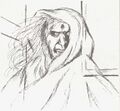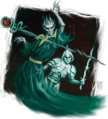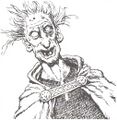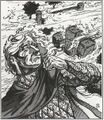Ghost: Difference between revisions
1d4chan>Zimriel |
1d4chan>TheSpoilerHeretic No edit summary |
||
| Line 7: | Line 7: | ||
You most likely know all of this already. Why did you even come to this article? | You most likely know all of this already. Why did you even come to this article? | ||
== Depiction in various media and ideology == | |||
In science, ghost were theorized to be beings made out of a spiritual substance called '''Ectoplasm'''(In greek Ecto means "outside", and plasma means "something formed or molded"). The term was not accept by science however, but were widespread in pop culture. | |||
Ghost are generally unharmed by any physical means (arrow, swords, bullets). In certain depiction they can be harmed by flame. To truly able to damage them, any kinds of magical enchanted weapon is needed. In a more mordern science fiction setting, [[Psionics|psychic power]] from a person can harm them with their power. | |||
To combat ghost without magic or psychic power, there are scientists in some setting that combats them with some sort of electrical magnetic device that shoots lightning. Most notably in Ghostbusters, a nuclear powered device called P'''particle accelerator system''' (or Proton Pack) is used to create a charged particle beam that can restrain ghosts (also known as negatively charged ectoplasmic entities in the movie setting). | |||
==Dungeons & Dragons== | ==Dungeons & Dragons== | ||
Revision as of 05:34, 4 July 2021

A Ghost (also known as spooks, specters, and phantoms; known erroneously as geists, ghouls, phantasms, or spooky bois), is the restless spirit of a deceased humanoid (or, rarely, animal) that returns from the grave to haunt the world of the living. The reason why varies immensely from ghost to ghost; common individual reasons include a need to achieve some task they failed in life, making amends for wrongs they committed, seeing to the protection of something or someone dear to them, pursuing vengeance, or simply failing to realize they are actually dead.
The standard form of a ghost is a pale, translucent figure, often seemingly obscured by mist or blurry, even when observed at conversational ranges. Ghosts are often cloaked in robes or sheets, reminiscent of depictions of angels in loose togas, but more eerie. By the 20th Century the stereotypical ghost had evolved into a see-though figure cloaked entirely in a sheet. They were capable of walking through walls and other solid objects, and their presence often made the immediate area unusually cold. They could be antagonistic or helpful, ranging from bad omens, deceased loved ones coming back to check on their still-living family to vengeful spirits with legitimate grievances against their killers. This depiction is a classic horror monster, and sets itself apart from the more Christianity-centric depictions of the spirits of the deceased which had come before in popular Western culture.
More modern depictions of ghosts are closer to ethereal monsters, having malleable or stretchy features and being capable of appearing and disappearing at will. These very recent depictions of ghosts follow more closely to the malevolent poltergeist depiction, acting maliciously, guarding locations, and performing jump-scares on unknowing victims. This may be due more to modern horror trends than the definition of "ghost" evolving to fit the times.
You most likely know all of this already. Why did you even come to this article?
Depiction in various media and ideology
In science, ghost were theorized to be beings made out of a spiritual substance called Ectoplasm(In greek Ecto means "outside", and plasma means "something formed or molded"). The term was not accept by science however, but were widespread in pop culture.
Ghost are generally unharmed by any physical means (arrow, swords, bullets). In certain depiction they can be harmed by flame. To truly able to damage them, any kinds of magical enchanted weapon is needed. In a more mordern science fiction setting, psychic power from a person can harm them with their power.
To combat ghost without magic or psychic power, there are scientists in some setting that combats them with some sort of electrical magnetic device that shoots lightning. Most notably in Ghostbusters, a nuclear powered device called Pparticle accelerator system (or Proton Pack) is used to create a charged particle beam that can restrain ghosts (also known as negatively charged ectoplasmic entities in the movie setting).
Dungeons & Dragons
The ghost has been part of D&D since the 1970s, with the ability to hit enemies with aging rather than energy-drain. Just seeing one might inflict 10 years and also cause the viewer to flee in terror. The ghost was a 10 HD undead, to be Turned above vampire-level at 9 HD. As a result - for the early 1980s - the ghost could be encountered only in AD&D campaigns. In that other early-'80s branch, Tom Moldvay's, the ghost was too powerful for Basic and Expert play. Jean Wells in 1981 tried nerfing one for B3: Palace of the Silver Princess (turned as a wight); but you know how THAT worked out.
The lore had stuck Frank Mentzer with the problem of how to detail, and to assign, an undead even more powerful than the vampire. It wasn't about the HD, since Expert play allowed all manner of 10 HD beasties - it was all the other special abilities. Mentzer eventually buffed up the ghost enough for the "Haunt" subtype, Companion Set; and he took away the Fear effect, relocating that to the weaker "Phantom" subtype. Ghosts were the only undead as weren't all Chaotic (=evil). Note that the "Haunt" appears between Gargantua and Gremlin (also out of order); likely is that "Ghost" was at first the subset with "Banshee", "Poltergeist" and perhaps "Haunt" as the genera within it.
Gallery
-
1e
-
2e
-
3e
-
4e
-
5e
Others
-
Phantom
-
Haunt
-
Poltergeist
-
Bussengeist
-
Valpurgeist
Ghost Women, and Lust Therefore

Yeah, that figures. Not that we're judging.
Strangely, ghosts are the most likely of the undead to get the Monstergirls treatment, perhaps because it's easy to get away with just portraying them as attractive human women who happen to have unusual abilities, like walking through walls or flying. This is aided by the fact that there are many, many stories in real life folklore and mythology of women becoming ghosts out of love in some fashion, including the "ghost girl who wants to find love despite being undead". Ghostly romance stories are surprisingly in vogue over on /a/.










